Abstract
Obligately anaerobic oxalate-degrading bacteria were isolated from an enriched population of rumen bacteria in an oxalate-containing medium that had been depleted of other readily metabolized substrates. These organisms, which are the first reported anaerobic oxalate degraders isolated from the rumen, were gram negative, nonmotile rods. They grew in a medium containing sodium oxalate, yeast extract, cysteine, and minerals. The only substrate that supported growth was oxalate. Growth was directly related to the concentration of oxalate in the medium (1 to 111 mM), and cell yields were approximately 1.1 g (dry weight)/mol of oxalate degraded. Oxalate was stoichiometrically degraded to CO2 and formate. These anaerobes occupy a unique ecological niche and are distinct from any previously described oxalate-degrading bacteria.
Full text
PDF
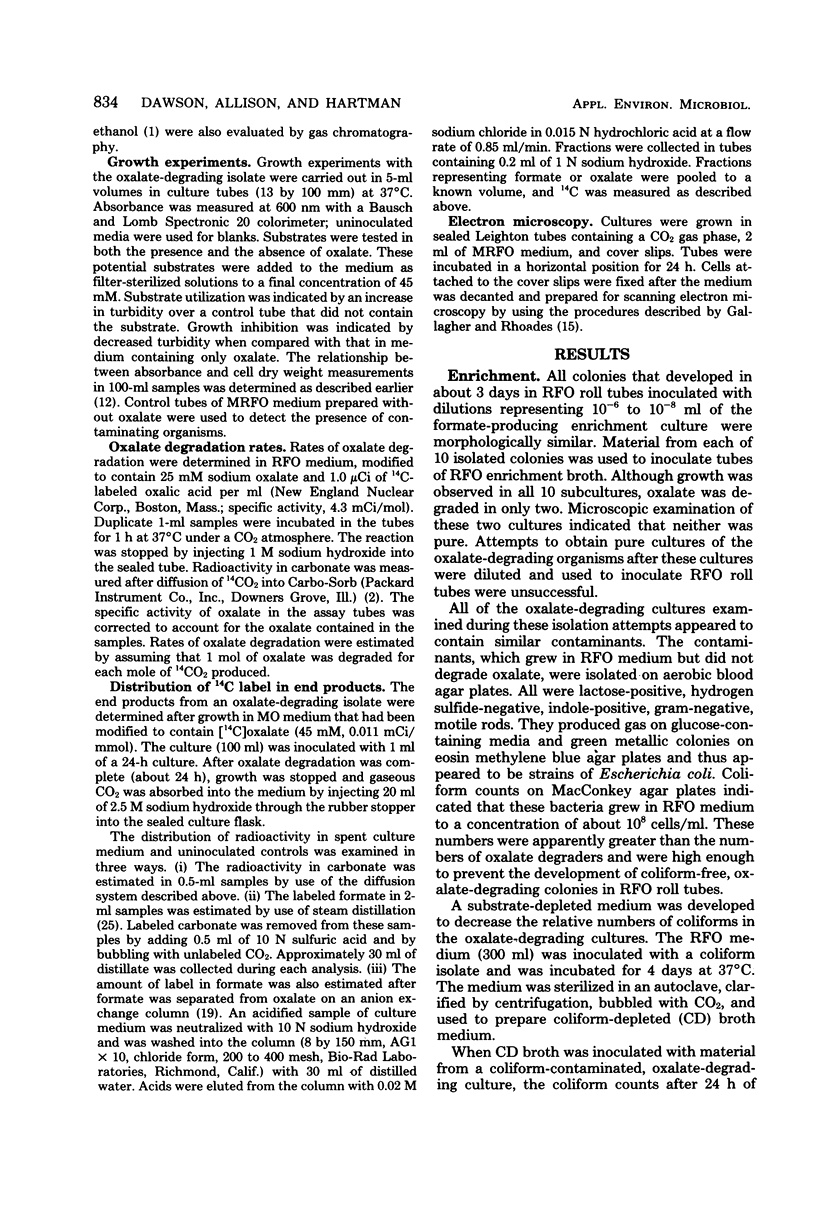
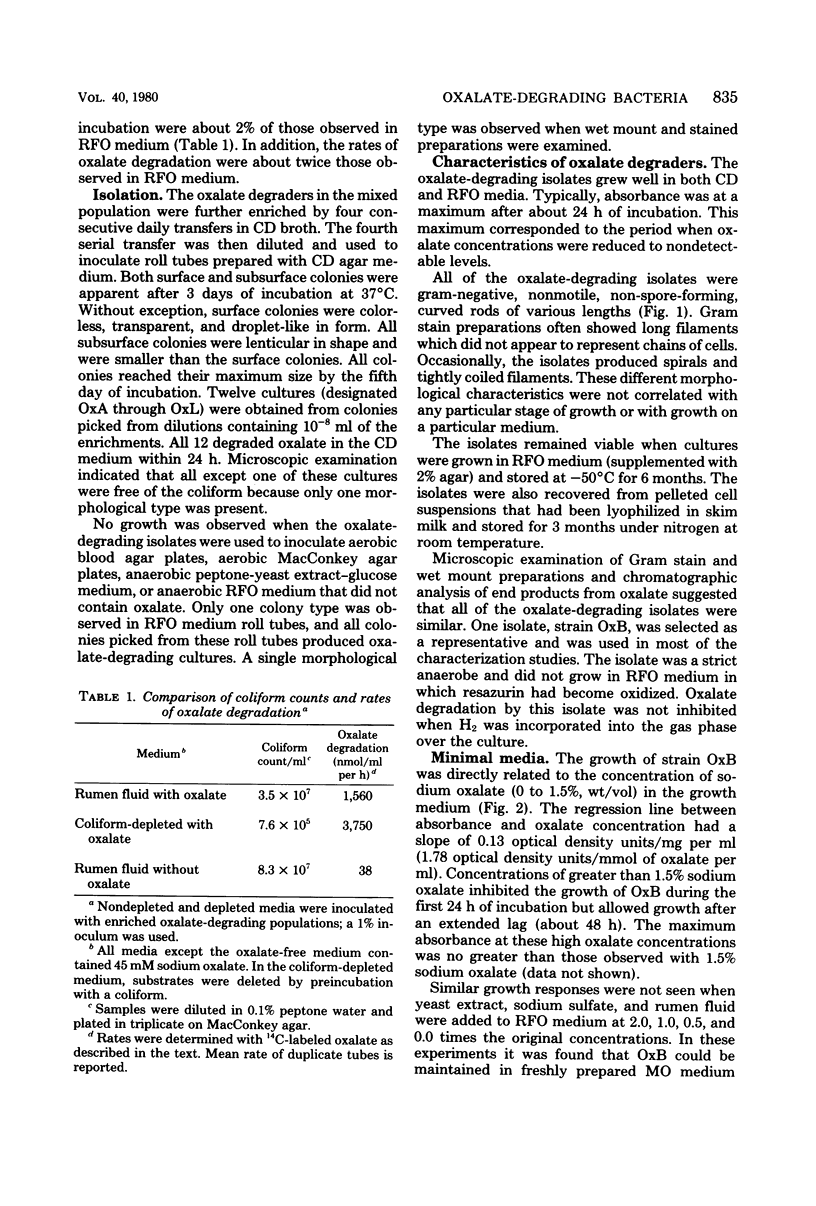
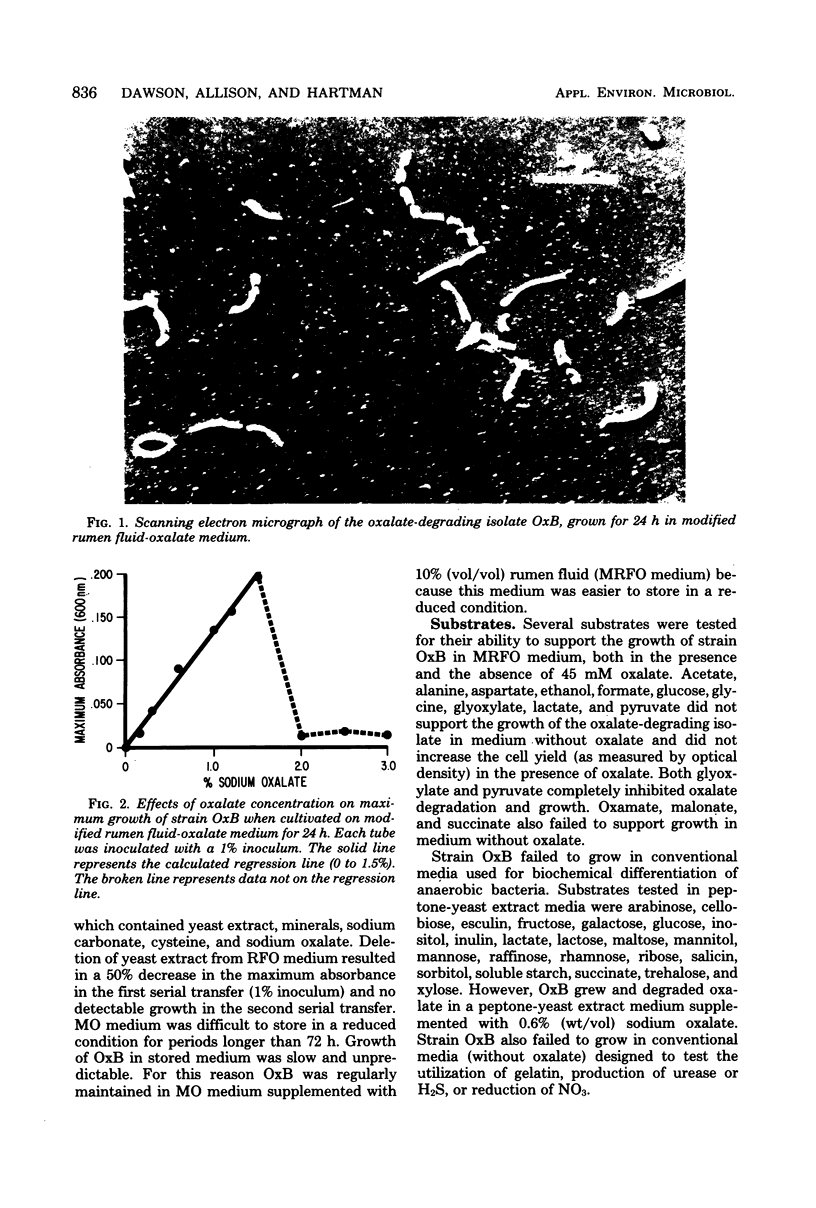
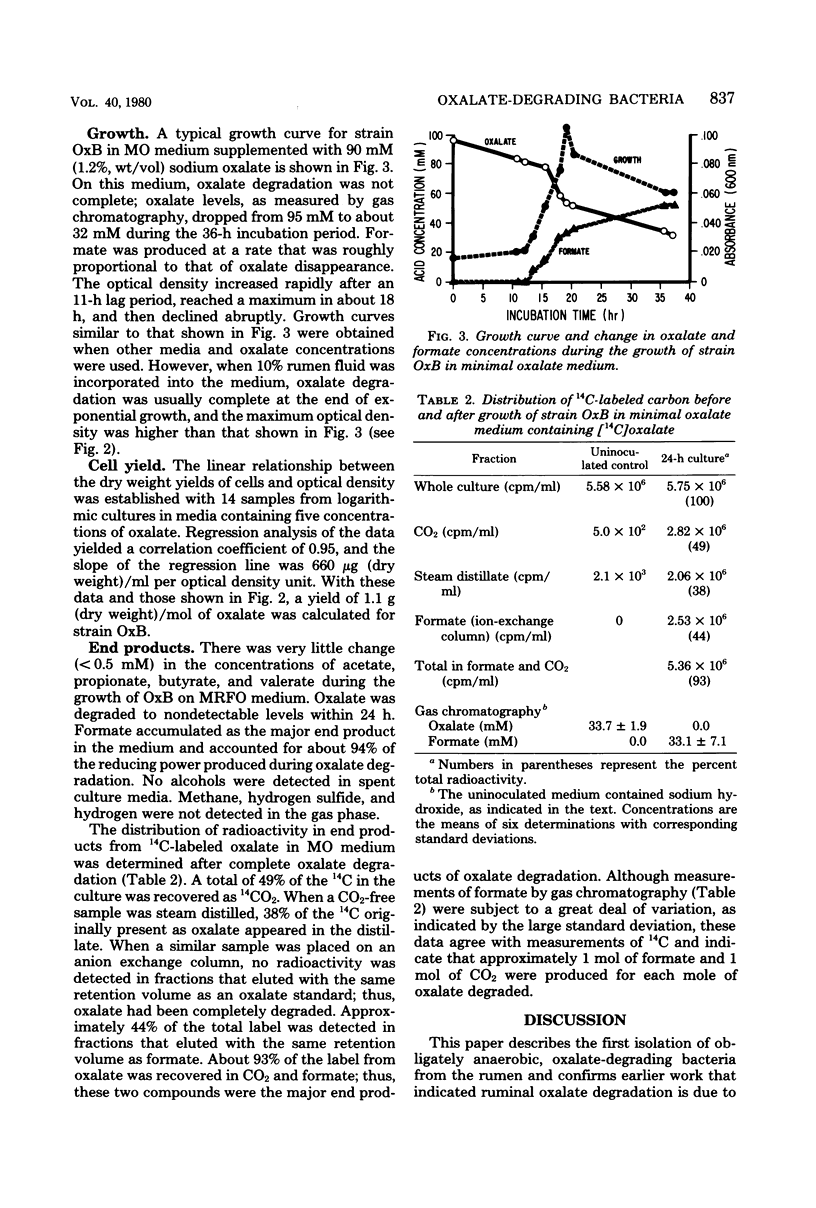
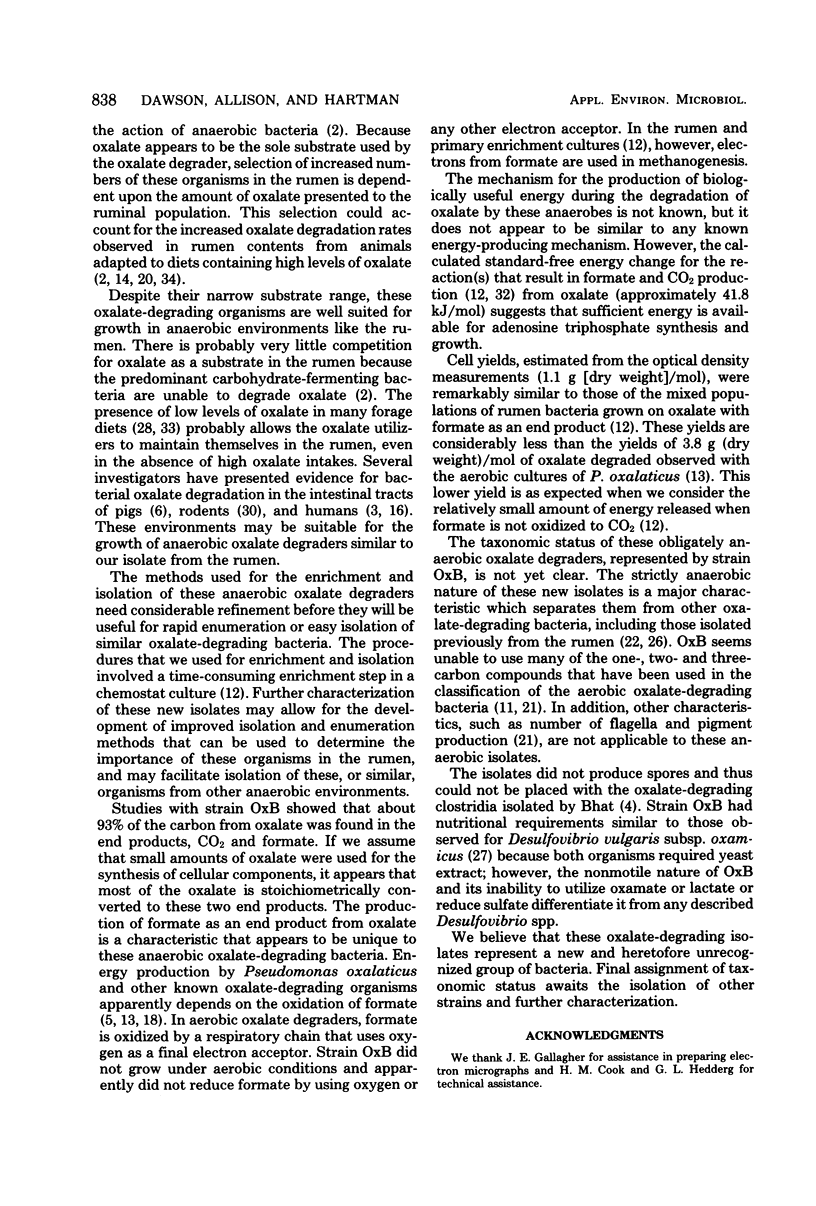

Images in this article
Selected References
These references are in PubMed. This may not be the complete list of references from this article.
- ALLISON M. J., DOUGHERTY R. W., BUCKLIN J. A., SNYDER E. E. ETHANOL ACCUMULATION IN THE RUMEN AFTER OVERFEEDING WITH READILY FERMENTABLE CARBOHYDRATE. Science. 1964 Apr 3;144(3614):54–55. doi: 10.1126/science.144.3614.54. [DOI] [PubMed] [Google Scholar]
- Allison M. J., Littledike E. T., James L. F. Changes in ruminal oxalate degradation rates associated with adaptation to oxalate ingestion. J Anim Sci. 1977 Nov;45(5):1173–1179. doi: 10.2527/jas1977.4551173x. [DOI] [PubMed] [Google Scholar]
- Barber H. H., Gallimore E. J. The metabolism of oxalic acid in the animal body. Biochem J. 1940 Feb;34(2):144–148. doi: 10.1042/bj0340144. [DOI] [PMC free article] [PubMed] [Google Scholar]
- Blackmore M. A., Quayle J. R. Microbial growth on oxalate by a route not involving glyoxylate carboligase. Biochem J. 1970 Jun;118(1):53–59. doi: 10.1042/bj1180053. [DOI] [PMC free article] [PubMed] [Google Scholar]
- Bryant M. P. Commentary on the Hungate technique for culture of anaerobic bacteria. Am J Clin Nutr. 1972 Dec;25(12):1324–1328. doi: 10.1093/ajcn/25.12.1324. [DOI] [PubMed] [Google Scholar]
- Chandra T. S., Shethna Y. I. Isolation and characterization of some new oxalate-decomposing bacteria. Antonie Van Leeuwenhoek. 1975;41(1):101–111. doi: 10.1007/BF02565041. [DOI] [PubMed] [Google Scholar]
- Chandra T. S., Shethna Y. I. Oxalate and formate in Alcaligenes and Pseudomonas species. Antonie Van Leeuwenhoek. 1975;41(4):465–477. doi: 10.1007/BF02565090. [DOI] [PubMed] [Google Scholar]
- Chandra T. S., Shethna Y. I. Oxalate, formate, formamide, and methanol metabolism in Thiobacillus novellus. J Bacteriol. 1977 Aug;131(2):389–398. doi: 10.1128/jb.131.2.389-398.1977. [DOI] [PMC free article] [PubMed] [Google Scholar]
- Dawson K. A., Allison M. J., Hartman P. A. Characteristics of anaerobic oxalate-degrading enrichment cultures from the rumen. Appl Environ Microbiol. 1980 Oct;40(4):840–846. doi: 10.1128/aem.40.4.840-846.1980. [DOI] [PMC free article] [PubMed] [Google Scholar]
- Dijkhuizen L., Wiersma M., Harder W. Energy production and growth of Pseudomonas oxalaticus OX1 on oxalate and formate. Arch Microbiol. 1977 Nov 18;115(2):229–236. doi: 10.1007/BF00406379. [DOI] [PubMed] [Google Scholar]
- Gallagher J. E., Rhoades K. R. Simplified preparation of mycoplasmas, an acholeplasma, and a spiroplasma for scanning electron microscopy. J Bacteriol. 1979 Feb;137(2):972–976. doi: 10.1128/jb.137.2.972-976.1979. [DOI] [PMC free article] [PubMed] [Google Scholar]
- HAYAISHI O., JAKOBY W. B., OHMURA E. Enzymatic decarboxylation of oxalic acid. J Biol Chem. 1956 Sep;222(1):435–446. [PubMed] [Google Scholar]
- JAKOBY W. B., BHAT J. V. Microbial metabolism of oxalic acid. Bacteriol Rev. 1958 Jun;22(2):75–80. doi: 10.1128/br.22.2.75-80.1958. [DOI] [PMC free article] [PubMed] [Google Scholar]
- JAYASURIYA G. C. The isolation and characteristics of an oxalate-decomposing organism. J Gen Microbiol. 1955 Jun;12(3):419–428. doi: 10.1099/00221287-12-3-419. [DOI] [PubMed] [Google Scholar]
- James L. F., Street J. C., Butcher J. E. In vitro degradation of oxalate and of cellulose by rumen ingesta from sheep fed Halogeton glomeratus. J Anim Sci. 1967 Nov;26(6):1438–1444. doi: 10.2527/jas1967.2661438x. [DOI] [PubMed] [Google Scholar]
- KHAMBATA S. R., BHAT J. V. Studies on a new oxalate-decomposing bacterium, Pseudomonas oxalaticus. J Bacteriol. 1953 Nov;66(5):505–507. doi: 10.1128/jb.66.5.505-507.1953. [DOI] [PMC free article] [PubMed] [Google Scholar]
- POSTGATE J. R. A STRAIN OF DESULFOVIBRIO ABLE TO USE OXAMATE. Arch Mikrobiol. 1963 Sep 16;46:287–295. doi: 10.1007/BF00422189. [DOI] [PubMed] [Google Scholar]
- Salanitro J. P., Muirhead P. A. Quantitative method for the gas chromatographic analysis of short-chain monocarboxylic and dicarboxylic acids in fermentation media. Appl Microbiol. 1975 Mar;29(3):374–381. doi: 10.1128/am.29.3.374-381.1975. [DOI] [PMC free article] [PubMed] [Google Scholar]
- Shirley E. K., Schmidt-Nielsen K. Oxalate metabolism in the pack rat, sand rat, hamster and white rat. J Nutr. 1967 Apr;91(4):496–502. doi: 10.1093/jn/91.4.496. [DOI] [PubMed] [Google Scholar]
- Thauer R. K., Jungermann K., Decker K. Energy conservation in chemotrophic anaerobic bacteria. Bacteriol Rev. 1977 Mar;41(1):100–180. doi: 10.1128/br.41.1.100-180.1977. [DOI] [PMC free article] [PubMed] [Google Scholar]
- Ward G., Harbers L. H., Blaha J. J. Calcium-containing crystals in alfalfa: their fate in cattle. J Dairy Sci. 1979 May;62(5):715–722. doi: 10.3168/jds.S0022-0302(79)83314-7. [DOI] [PubMed] [Google Scholar]



